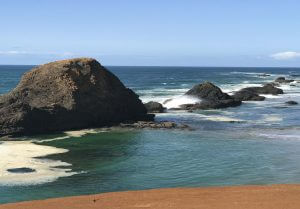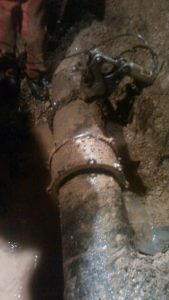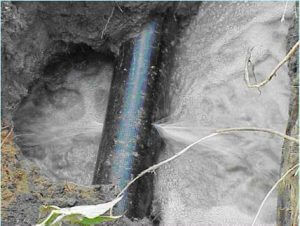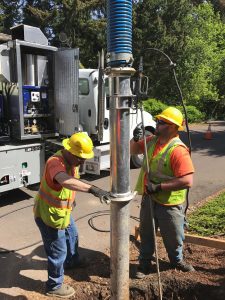Rural Communities At Risk: Vital Water Funding Needs Continued Support

Seal Rock State Park, Oregon (Credit: Seal Rock Water District)
In the Pacific Northwest, the risk of a Cascadia earthquake is high, and in that situation, fresh water will be the most critical need.
Communities need to think ahead, but small communities often don’t have the resources to do so. Seal Rock Water District (SRWD) on Oregon coast has found a way to prepare for the future. The water system for this 5,500 year-round population is aging and at risk of the predicted earthquake. Adam Denlinger, General Manager for SRWD, identified a way to support his customers in case of the loss of service in an emergency. As an alternative to this vulnerable supply, the District intends to develop its own water supply system from Beaver Creek, which is centrally located within the District’s service boundaries.

Degraded pipes (Credit: Seal Rock Water District)
Mr. Denlinger was not able to seek conventional loans for this water infrastructure safeguard. The community’s small population makes it difficult, if not impossible to collect sufficient revenue to repay loans that larger communities can take on. Instead, he is piecing together several funding sources. USDA Rural Development Water and Wastewater Loans and Grants are the lynchpin to his plan, with a grant component that will lower his repayment needs.
Water Infrastructure Program for Small Communities
The Rural Development Water and Wastewater Infrastructure Loans and Grants (WWILG) are authorized by the Farm Bill and administered by USDA. These funds were established for communities with population of 10,000 or less. They are a critical lifeline for communities often providing services to lower income and vulnerable populations. These funds support fundamental maintenance to water and wastewater treatment and distribution systems, upgrades to address problem contaminants, and expansion to allow for economic development.
In Washington and Oregon, many infrastructure projects in small, rural communities per year depend on these flexible funds. What is the scale of this program? In FY 2017, approximately $15 million was allocated to loans and $5 million to grants in Oregon. In Washington, loans were closer to $21 million and grants were $5.2 million for the same year.
What’s at Risk

Leaky pipe (Credit: Seal Rock Water District)
In FY17 at the national level, these loans and grants were funded at just over $571 million. In May 2017, the Trump FY18 Budget proposed complete elimination of this fund, citing redundancy with other water infrastructure funds as the reason. Fortunately, the truth about the value and distinction of these funds were communicated to Congress, and when funding the USDA for FY18, this fund was doubled.
Unfortunately, that level of support for these under-resourced communities is not a given going forward.
Farm Bill and Annual Funding
All the programs of the US Department of Agriculture are currently due for reauthorization this year, including the WWILG and many other programs that help our small rural communities thrive and allow them to protect local waters. The vehicle for these authorities is called the “Farm Bill” for short.
The Farm Bill is scheduled for reauthorization, or renewal, every five years. That means that the programs and their budget authorizations are reconsidered and up for debate. In addition, every year Congress must pass the specific funding amounts to implement the Farm Bill. River Network participates in the national Clean Water for All Coalition, which has outlined a set of principles to guide Farm Bill advocacy for the protection of waters in agricultural areas. This shorthand list represents the topics that may also be important in your watershed or state.
- Increase funding
- Protect linkage between basic conservation requirements and crop insurance; protect programs that keep soil out of waterways and protect wetlands
- Increase access to funding and technical assistance for communities who need them most
- Encourage greater targeting of funds towards areas that need it the most, e.g. drinking water sources
- Improve measurement, reporting, and evaluation of conservation program outcomes
- Create incentives for, and eliminate barriers to, water-friendly agricultural practices within the Federal Crop Insurance Program.
Congressional Update: Farm Bill and Appropriations
The House of Representatives narrowly passed a version of the Farm Bill that proposes $800 million in damaging cuts to vital conservation programs over the next 10 years as well as including policy riders that dismantle water protections, such as the Clean Water Rule. This bill failed to pass due to disagreements about immigration reform, but on 6/22 after much negotiation the bill passed.
The Senate is due to vote on their version of the Farm Bill before the end of this week. This version does not have the drastic cuts nor the damaging policy riders of the House bill, however it does not go as far as the House in two positive areas: increased acreage in the Conservation Reserve Program and including the “Faso Amendment” that requires more measurement and evaluation of conservation outcomes from the federal investment in conservation programs. Those are two areas for improvement on the Senate floor in the coming days.
If the Senate is able to pass its own version, the two chambers will have much work to do to reconcile the dramatic differences between the two bills before the current Farm Bill expires on September 30th.
Congress is also working on the specific funding for the next fiscal year (FY19) which starts on October 1, 2018. Last month both the House and the Senate passed bills allocating funds for the US Department of Agriculture in FY19. The Rural Development Water and Wastewater Infrastructure funds were funded at or above FY18 level, in spite of cuts that had been proposed by the Administration.
What You Can Do

Credit: Seal Rock Water District
1. Tell your Senators and your Representatives that you (and your members) care about the reauthorization of a CLEAN Farm Bill with no damaging environmental policy riders.
2. Urge them to pass the Senate version of the bill – – with restoration to the working lands programs.
3. Ask them if they know about the water infrastructure loans and grants. If not, share some talking points to be sure to protect the levels of funding in the FY19 USDA Appropriations bills:
- Serves very small, financially distressed rural communities with population of 10,000 or less and rural tribal areas
- Long-term, low-interest loans, often combined with grants
- Essential funding for communities that can’t obtain conventional loans
- Projects may solve contamination problems, replace failing pipes, or provide additional capacity that supports economic development
If you want more information on the Farm Bill and federal funding in agricultural watersheds, you can watch the webinar River Network hosted for groups in Pennsylvania last week featuring Alyssa Charney from the National Sustainable Agriculture Coalition and Ezra Thrush from PennFuture. Most of the information is relevant for all states.




